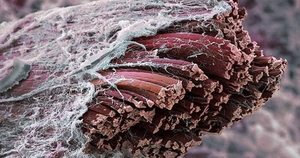Skeletal Muscle: Difference between revisions
No edit summary |
No edit summary |
||
| Line 5: | Line 5: | ||
</div> | </div> | ||
== Introduction == | == Introduction == | ||
[[File:Fascia surrounding muscle fibre.png|thumb|Fascia surrounding muscle fibre]] | |||
Skeletal [[muscle]] attaches to the [[bone]] by [[Tendon Anatomy|tendons]], and together they produce all body movements. However it has important roles in health beyond voluntary movement. Human skeletal muscle is an extremely dynamic and responsive tissue. Humans skeletal muscle constitutes roughly 40% of total body weight and a huge 50-75% of all the bodies [[Muscle Proteins|proteins]]. Our muscle mass muscle mass depends on the dynamic process of protein synthesis and loss, this activity being responsive to factors including [[Nutrition|nutritional]] status, [[Hormones|hormonal]] balance, [[Physical Activity|physical activity]]/[[Therapeutic Exercise|exercise]], and [[Muscle Injuries|injury]] or [[Muscle Disorders|disease]]. As such it has important roles in health beyond voluntary movement.<ref name=":0">Frontera WR, Ochala J. [https://pubmed.ncbi.nlm.nih.gov/25294644/ Skeletal muscle: a brief review of structure and function.] Calcified tissue international. 2015 Mar;96:183-95.Available:https://pubmed.ncbi.nlm.nih.gov/25294644/ (accessed 16.4.2023)</ref><ref>Graham ZA, Lavin KM, O’Bryan SM, Thalacker-Mercer AE, Buford TW, Ford KM, Broderick TJ, Bamman MM. [https://www.ncbi.nlm.nih.gov/pmc/articles/PMC8424676/ Mechanisms of exercise as a preventative measure to muscle wasting.] American Journal of Physiology-Cell Physiology. 2021 Jul 1;321(7):C40-57.Available:https://www.ncbi.nlm.nih.gov/pmc/articles/PMC8424676/ (accessed 16.4.2023)</ref> | Skeletal [[muscle]] attaches to the [[bone]] by [[Tendon Anatomy|tendons]], and together they produce all body movements. However it has important roles in health beyond voluntary movement. Human skeletal muscle is an extremely dynamic and responsive tissue. Humans skeletal muscle constitutes roughly 40% of total body weight and a huge 50-75% of all the bodies [[Muscle Proteins|proteins]]. Our muscle mass muscle mass depends on the dynamic process of protein synthesis and loss, this activity being responsive to factors including [[Nutrition|nutritional]] status, [[Hormones|hormonal]] balance, [[Physical Activity|physical activity]]/[[Therapeutic Exercise|exercise]], and [[Muscle Injuries|injury]] or [[Muscle Disorders|disease]]. As such it has important roles in health beyond voluntary movement.<ref name=":0">Frontera WR, Ochala J. [https://pubmed.ncbi.nlm.nih.gov/25294644/ Skeletal muscle: a brief review of structure and function.] Calcified tissue international. 2015 Mar;96:183-95.Available:https://pubmed.ncbi.nlm.nih.gov/25294644/ (accessed 16.4.2023)</ref><ref>Graham ZA, Lavin KM, O’Bryan SM, Thalacker-Mercer AE, Buford TW, Ford KM, Broderick TJ, Bamman MM. [https://www.ncbi.nlm.nih.gov/pmc/articles/PMC8424676/ Mechanisms of exercise as a preventative measure to muscle wasting.] American Journal of Physiology-Cell Physiology. 2021 Jul 1;321(7):C40-57.Available:https://www.ncbi.nlm.nih.gov/pmc/articles/PMC8424676/ (accessed 16.4.2023)</ref> | ||
| Line 15: | Line 16: | ||
Many medical conditions occur due to abnormalities in skeletal muscles' function. | Many medical conditions occur due to abnormalities in skeletal muscles' function. | ||
* These include myopathy, paralysis, myasthenia gravis, urinary and/or bowel incontinence, ataxia, weakness, tremors, and others. | * These include [[Myopathies|myopathy]], paralysis eg [[Spinal Cord Injury|spinal cord injury]], [[Myasthenia Gravis|myasthenia gravis]], urinary and/or bowel [[Urinary Incontinence|incontinence]], [[ataxia]], weakness, tremors, and others. | ||
* Neuronal disorders can cause neuropathy and cause alterations in skeletal muscles | * Neuronal disorders can cause neuropathy and cause alterations in skeletal muscles function. | ||
* Skeletal muscle/tendon ruptures also occur acutely and cause serious disability in patients regardless of how active they are.<ref name=":0" /> | * Skeletal muscle/[[Tendon Pathophysiology|tendon ruptures]] also occur acutely and cause serious disability in patients regardless of how active they are.<ref name=":0" /> | ||
== References == | == References == | ||
Revision as of 08:03, 16 April 2023
Original Editor - Lucinda hampton
Top Contributors - Lucinda hampton
Introduction[edit | edit source]
Skeletal muscle attaches to the bone by tendons, and together they produce all body movements. However it has important roles in health beyond voluntary movement. Human skeletal muscle is an extremely dynamic and responsive tissue. Humans skeletal muscle constitutes roughly 40% of total body weight and a huge 50-75% of all the bodies proteins. Our muscle mass muscle mass depends on the dynamic process of protein synthesis and loss, this activity being responsive to factors including nutritional status, hormonal balance, physical activity/exercise, and injury or disease. As such it has important roles in health beyond voluntary movement.[1][2]
Skeletal muscle fibers are crossed with a orderly pattern of fine red and white lines, hence its name striated muscle. For more on anatomical structure see Muscle Cells (Myocyte)
Biomechanical Organ[edit | edit source]
Muscle can be viewed as a biomechanical organ requiring the coordination between diverse factors both intrinsic (e.g., genetic) and extrinsic (e.g., environmental stressors, circulatory factors, etc.) to function normally, with each of these components cross talking. Abnormal molecular mechanisms can lead to disease and muscle research at many levels (genomic, molecular and mechanistic) is helping in the prevention and management of skeletal muscle health and disease.[3]
Abnormalities[edit | edit source]
Many medical conditions occur due to abnormalities in skeletal muscles' function.
- These include myopathy, paralysis eg spinal cord injury, myasthenia gravis, urinary and/or bowel incontinence, ataxia, weakness, tremors, and others.
- Neuronal disorders can cause neuropathy and cause alterations in skeletal muscles function.
- Skeletal muscle/tendon ruptures also occur acutely and cause serious disability in patients regardless of how active they are.[1]
References[edit | edit source]
- ↑ 1.0 1.1 Frontera WR, Ochala J. Skeletal muscle: a brief review of structure and function. Calcified tissue international. 2015 Mar;96:183-95.Available:https://pubmed.ncbi.nlm.nih.gov/25294644/ (accessed 16.4.2023)
- ↑ Graham ZA, Lavin KM, O’Bryan SM, Thalacker-Mercer AE, Buford TW, Ford KM, Broderick TJ, Bamman MM. Mechanisms of exercise as a preventative measure to muscle wasting. American Journal of Physiology-Cell Physiology. 2021 Jul 1;321(7):C40-57.Available:https://www.ncbi.nlm.nih.gov/pmc/articles/PMC8424676/ (accessed 16.4.2023)
- ↑ Mukund K, Subramaniam S. Skeletal muscle: A review of molecular structure and function, in health and disease. Wiley Interdisciplinary Reviews: Systems Biology and Medicine. 2020 Jan;12(1):e1462.Available:https://www.ncbi.nlm.nih.gov/pmc/articles/PMC6916202/ (accessed 16.4.2023)







